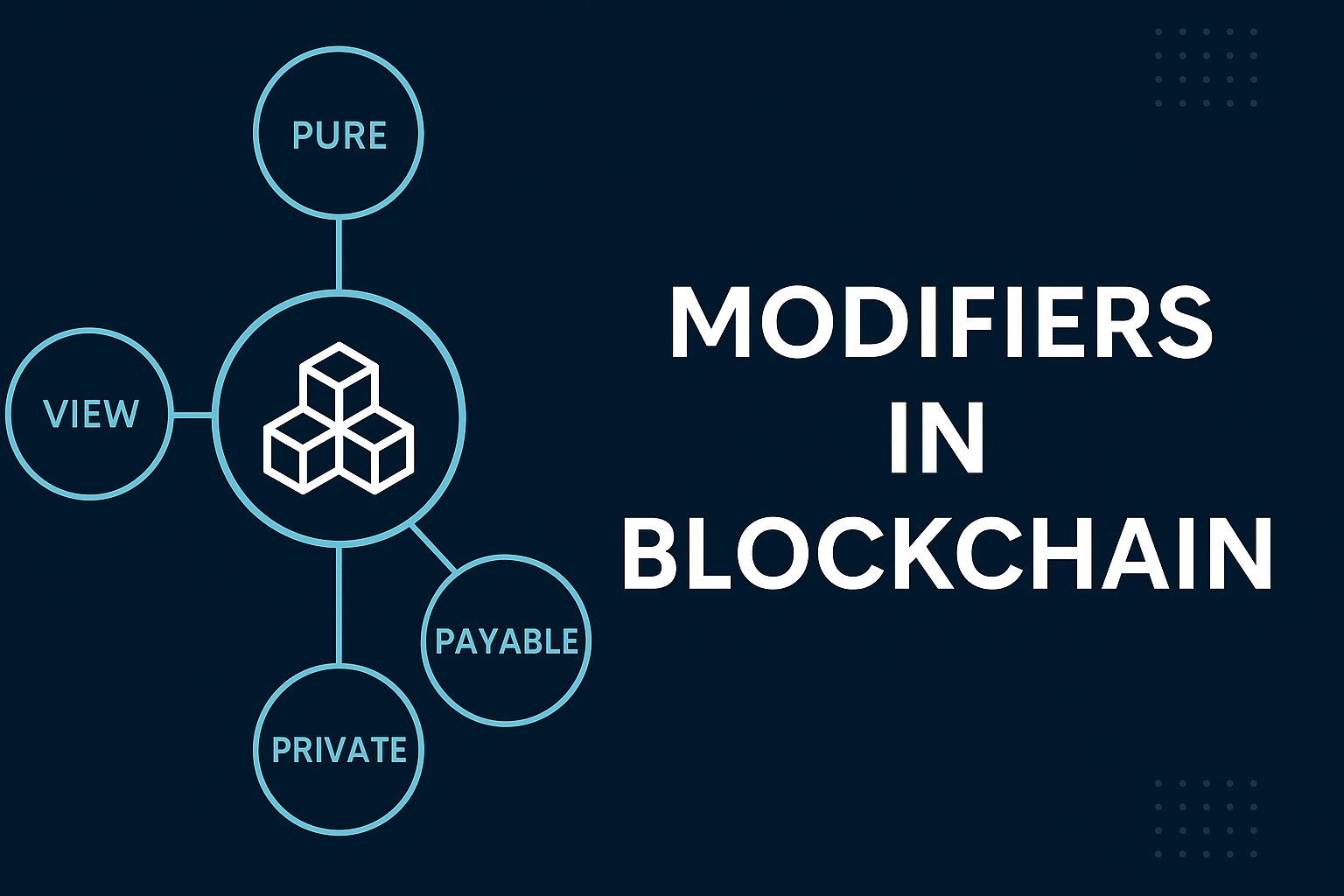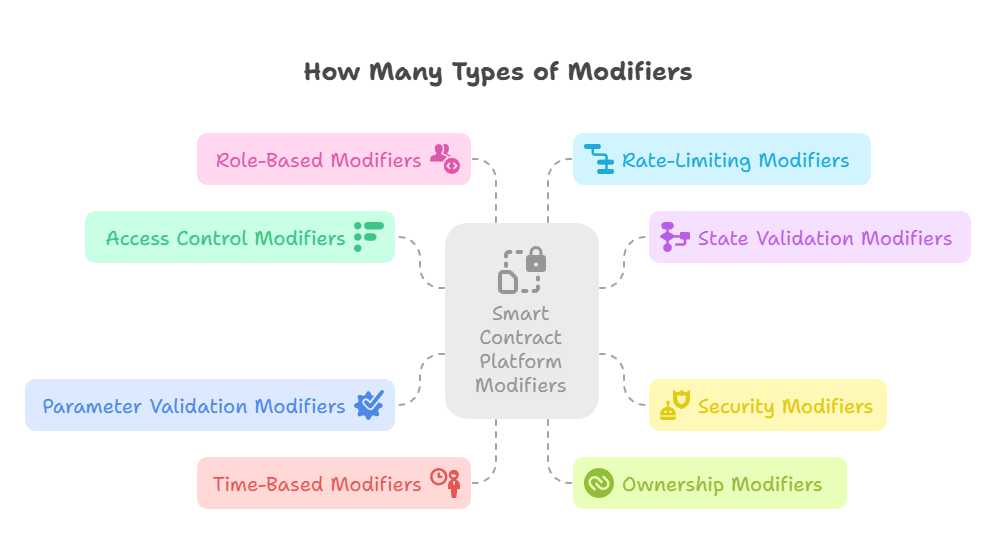Modifiers in Blockchain
In this article, we learn about how many types of modifiers in blockchain, how they work and so on.
In Solidity smart contracts, modifiers are strong features that change a function’s behaviour in a reusable manner. By imposing particular requirements or limitations prior to the execution of a function’s code, they serve as gatekeepers. They are essentially codes that can be appended to functions in order to manage access, verify inputs, or carry out other crucial inspections.

Modifiers in blockchain
What Modifiers Do and How They Work
One particular kind of Solidity function that is used to change the behaviour of other functions is called a modifier. They have the ability to automatically check conditions either before or after a function runs.
Key functions of modifiers include:
- Access Control: Modifiers can restrict who can execute certain functions or access specific data within a smart contract, ensuring only authorized users or roles can perform actions.
- Input Validation: They can validate input parameters to functions, preventing invalid or malicious data from causing errors or unexpected behaviour.
- By setting conditions for a function to perform, conditional execution permits more complex logic and control flow.
- Preventing Attacks: They can help mitigate risks such as reentrancy attacks by adding checks before function execution.
- Setting up the environment: Modifiers can set up the environment for a function to execute, such as ensuring a certain amount of Ether is sent.
You can also read Blockchain Attestation: Verifying Trust & Data on the Ledger
How modifiers work (Execution Flow):
Solidity runs code within a modifier before performing the function’s logic. Solidity employs the ; symbol (also called Merge Wildcard) to substitute the function’s code and the modifier keyword to define the modifier. The modifier condition is met, the function code replaces the ; symbol, and the code is run. The transaction is reversed and the function halted if the prerequisites are not met. All modifiers must have the _; symbol, usually at the end to ensure conditions are checked and confirmed first.
Importance and Benefits for Smart Contract Developers
Smart contract developers need modifiers to manage situations and enforce rules methodically.
- Code Organization and Readability: They enhance code organization, readability, and maintainability by allowing developers to define reusable code that can be applied across multiple functions.
- Reduced Redundancy: Modifiers enable state validation, access control, and security checks without interfering with function logic, promoting consistency and reducing code duplication.
- Enhanced Security and Integrity: They aid in making sure that key requirements are fulfilled prior to functions starting, which is essential for preserving smart contracts’ security and integrity.
- Simplified Maintenance: By encapsulating shared logic, modifiers greatly improve the maintainability of smart contracts. It is possible to edit a check at a single location within the modifier, and the modification will be automatically applied to all functions that use it. This streamlines updates and debugging.
How Many Types of Modifiers in blockchain

How Many Types of Modifiers
There exist multiple categories of smart contract platform modifiers, each with a specific purpose:
- Function access is restricted by Access Control Modifiers according to the caller’s identity or permissions.
- A popular modifier that restricts the use of specific functions to the contract owner alone is onlyOwner.
- Only Authorized/only Admin: Restrict access to specific approved users or administrators.
- State Validation Modifiers make sure a smart contract is in the right state (active or in a particular phase, for example) before it performs a function.
- Smart contracts are protected from flaws and attacks by security modifiers.
- NonReentrant: Prevents reentrancy attacks by preventing a function from being called repeatedly before its completion.
- validation of parameters Modifiers make guarantee that input values that are supplied to functions satisfy certain requirements, including being in the right format or falling inside a suitable range. An amount can be dynamically validated, for example, using checkAmount.
- Time-based modifiers establish temporal restrictions, limiting the execution of functions according to a specific date or time.
- A smart contract’s owner or a designated party can only access a smart contract or its assets once Ownership Modifiers confirm who owns them.
- Based on roles Using predetermined roles that users are assigned under the contract, modifiers control access.
- To stop abuse, rate-limiting modifiers regulate how frequently specific functions can be invoked.
You can also read Decentralized Exchange Benefits: Future Of Crypto Trading
Furthermore, some ideas that are frequently used as modifiers or associated with function access in Solidity are as follows:
- public: The public modifier makes it simple to access functions and state variables from any location, including outside contracts. It’s similar to an open-door policy. As the most liberal modifier, anyone can use and interact with the variables and functions. Like a park, anyone can utilise the facilities and enjoy the environment.
- private: The private modifier locks the contract’s functions and state variables. This ensures that only the contract can inspect and change these components. It is hidden from the public like a private chamber in a home.
- Internal: The internal modifier opens a semi-open door to state variables and functions in the current contract and descendant contracts. It guarantees that these components cannot be accessible by outside parties, including users or contracts. It is comparable to a family get-together in which members of the family share resources and knowledge that are not available to outsiders. This modifier is very helpful when using Solidity for inheritance because it enables derived contracts to access and use the parent contract’s internal components.
- External: The external modifier facilitates access to functions only through external contracts or transactions, making it a one-way street. Contractual functions that are designated as external cannot be invoked inside. It is a means to guarantee that these functions are only called from outside the contract, preventing calls from within. Similar to a customer service desk, it is only accessible by external clients, restricting internal use by staff members. When defining functions intended exclusively for external contract interactions, the external modifier is the most common usage.
- View: When a function has this modifier, it means that it can only read data and cannot change the state of the contract.
- Pure: This modifier states that the function doesn’t even read the state of the contract, going beyond view.
- Payable: By allowing a function to receive Ether in addition to the function call, this modification makes financial transactions possible.
Syntax and Structure
A modifier definition generally follows this structure:
modifier name_of_modifier (parameters) {
require(conditions_to_be_checked);
_; // This represents the code that follows the modifier
}
- The modifier keyword is used to declare a modifier.
- Modifiers can have a name and accept parameters for flexible rule enforcement.
- The body of the modifier contains the conditions, often using the require() statement.
- The _; (underscore) symbol indicates where the code of the function the modifier is applied to will be inserted and executed.
To apply a modifier to a function, it is listed in the function’s header:
function myFunction(…) public modifierName(…) {
// Function logic
}
Advanced Modifier Patterns
- Modifiers with Arguments: Any Solidity-supported data type can be used as an argument. This enables dynamic validation using values that have been passed.
- Multiple Modifiers: By applying several modifiers to a single function, they can be listed in a list separated by whitespace. Due to their sequential evaluation, their order is important.
- Both inheritance and overriding are possible in derived contracts for modifiers. A new implementation is defined in the derived contract by using the override keyword, which is indicated by the virtual keyword that a modifier can be overridden.
- With enum-based modifiers, you may take an enum type as a parameter and specify a set of predetermined values that affect whether a function should execute.
Security Considerations and Best Practices
Security comes first when writing modifiers:
- Reentrancy Protection: Implement nonReentrant modifiers to prevent recursive calls before execution completes, guarding against reentrancy attacks.
- Gas Optimization: To prevent using too much gas, adjustments should be made. Avoid complex calculations and keep them simple to cut down on transaction expenses.
- Avoid Unintended Side Effects: Modifiers should not inadvertently change the state or execute code that affects the contract’s balance.
- Simplicity and Auditability: Keep modifier logic simple, coherent, and auditable. Avoid redundant data or unrelated functions within them.
- Explicit Rules: Use custom modifiers to clearly define rules, policies, and regulations for data access and function behaviours, rather than embedding complex if/else logic directly in functions.
- Documentation and Error Messages: Document the purpose and behaviour of each modifier clearly, and ensure they provide clear and actionable error messages for easier debugging.
- Reusability: Design modifiers to be reusable and modular, avoiding code duplication.
You can also read What Is Gas In Blockchain And How To Calculate Gas Fees
Relationship with Error Handling Functions
Modifiers are frequently used to manage transaction outcomes and impose requirements in combination with Solidity’s built-in error handling features:
- Require(): Usually used inside modifiers to verify inputs or check preconditions. The function executes again and all state changes are undone if the condition is not met.
- Revert(): Like require(), but with the ability to provide custom error messages, this function immediately ends the execution and reverts the current call.
- Assert(): Frequently used for invariant checking or internal errors, this function checks for conditions that should always be true. Similar to require(), an assert() that fails reverts the transaction and consumes up all of the gas that is left.
Contrast with Vyper
Although Solidity makes considerable use of modifiers, Vyper, another programming language used to create Ethereum smart contracts, does not. Instead, Vyper encourages writers to use assertions and inline checks directly within functions. This is meant to improve the auditability of smart contracts because the entire logic is visible right away, eliminating the need to mentally account for external modifier logic.
You can also read Applications of Directed Acyclic Graph, Benefits & Structure
